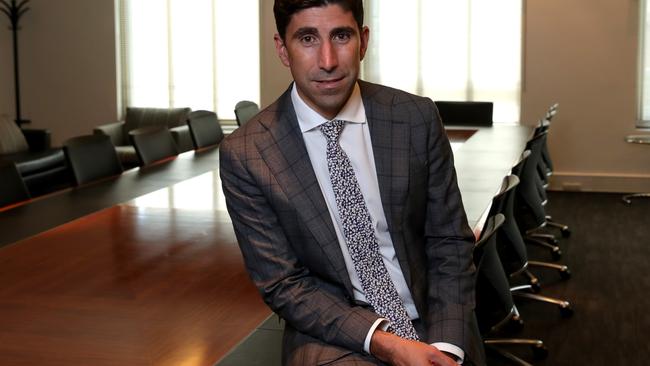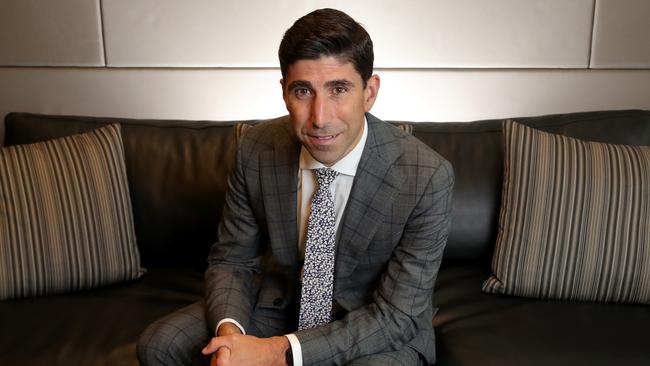Insignia Financial upgrades outlook after $49m interim net loss on transformation
CEO Renato Mota farewells investors in the wealth manager with a better than expected interim result after a 5-year long - and counting - turnaround.

Departing Insignia Financial chief executive Renato Mota, 48, says he leaves behind a wealth manager well-positioned to reclaim its place at the forefront of the industry.
“I say that with confidence because I think we’ve built the foundations for that,” Mr Mota told The Australian after unveiling better than expected interim result.
“What you’ll see in five years is an organisation that is one of the largest super funds in the country and growing (and) one of the most comprehensive advice businesses helping more Australians, all supported by a world class asset management business.”
Mr Mota has led the company previously known as IOOF since late 2018 after the Hayne inquiry aired poor corporate governance practices of such magnitude that half a decade later, remediation payments are still weighing on its financial performance.
On Thursday, it said large remediations and costs involved in its ongoing transformation had led to a bigger-than-feared $49m statutory loss for the six months to December. Underlying profit after tax, however, came at $95.5m, up 1.2 per cent from the previous year and about 9 per cent better than consensus estimates, according to Visible Alpha records.
Comparing Insignia with the company he inherited after the inquiry led to the sudden exit of both its previous CEO Chris Kelaher and chairman George Venardos, Mr Mota said he was proud of the turnaround.
“It’s not been an easy journey but I’m confident that with time we’ll recognise it as the right journey,” he said.
“I think we have delivered on our ambition of creating a leading organisation with the scale, capabilities and talent to grow and prosper for years to come.”
As part of the result, the group also announced an unfranked dividend of 9.3 cents a share, down from the 11 cents it paid a year earlier, but also better than analysts were expecting.
When asked about his future, Mr Mota was coy about any work-related plans after his term ends next week.
“I’m passionate about the industry and loved it for the last 25 years but my only focus at the moment is to take a bit of a break,” he said.
Investors were impressed. Insignia shares, which have lost over half their value in the past five years and are prone to high volatility, surged as much as 15.8 per cent after the result, before paring down some gains to close 13.7 per cent higher at $2.57 each. That was their best closing price since September.
The wealth manager upgraded its group net revenue margin for the full year to between 45.5 to 46.0 basis points, up from a previously guided 44.8 to 45.8 basis points.
Its EBITDA margin was also likely to be slightly better at between 11.8 to 12.2 basis points, up from 11.3 to 11.8 basis points, it said.
“Given the low trading multiple, we are not surprised to see the market react positively to the strong beat and upgraded guidance, although we would also highlight where it comes in the CEO cycle,” Citi analyst Nigel Pittaway told clients in a note.
Former AMP executive Scott Hartley, 60, who has flagged he plans to “accelerate” the execution of Insignia’s strategy, joins on Monday to start as CEO on March 1.
“The market will likely remain sceptical … given the company’s history,” Mr Pittaway said.

The statutory loss for the first half was much worse than the $16m loss forecast by a pool of analysts (although estimates varied greatly) and compares with a $45m statutory profit for the same period last year.
Insignia said it expected to make $55m in compensation payments in cash during the March quarter, including for advice and for product remediation.
It had completed the “fee for no advice” remediation programs and believed payments relating to “quality of advice” issues would be completed by June 30.
“Quality of advice involves pulling apart every piece of advice being given,” chief financial officer David Chalmers said at an investor briefing.
“Some may well have been poor quality of advice where the client has actually benefited, some where there’s been a loss. So, just by its nature, the variability around quality of advice, either positive or negative, is higher than fee for service.”
Underlying profit in its platforms business had fallen 9 per cent during the first half to $108m due to previously flagged expenses involving cyber security, governance, and its “license condition rectification,” with the prudential regulator.
A 7 per cent increase in funds under administration to $215bn had helped drive revenues one per cent higher in the unit to $478m, but margins had been squeezed by “strategic repricing” and simplification initiatives, it said.
Its Advice business posted an underlying $0.7m loss, despite higher fees from repricing in its Shadforth and Bridge brands, while advisers declined 21 per cent to 1,199, after it sold Millennium3, closed its Lonsdale licence, and “right sized” Bridges. It said the unit was on track to post $10m in underlying net profit after tax for the full year.
The company sold Godfrey Pembroke back to Practice Development Group – which represents Godfrey Pembroke advisers – in line with the new model to sell its struggling advisory businesses over time and instead work with them in a “partnership model”. The group contributed $1.8m in revenue.
The asset management unit saw $1.8bn in net outflows, while underlying profit shrunk 13.3 per cent to $30m compared to last year after it sold its minority stake in Jana.
“The current period profit result reflects significant investments in future growth and our desire to complete the remediation programmes,” said Mr Mota.
“It’s pleasing to see strong early progress against our FY24-26 strategic initiatives as we strengthen our foundation for growth and deliver the benefits of scale to our members, clients, and shareholders.”






To join the conversation, please log in. Don't have an account? Register
Join the conversation, you are commenting as Logout